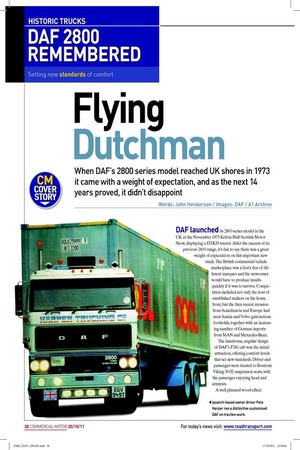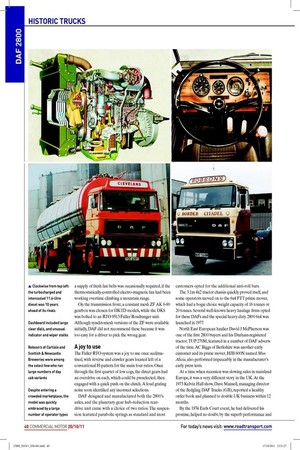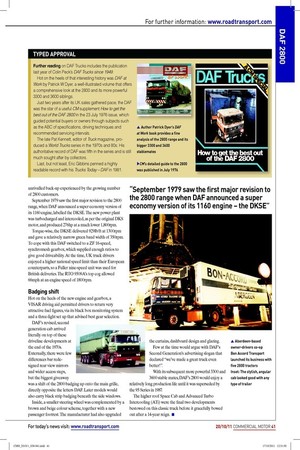Flying Dutchman
Page 28

Page 29

Page 30

Page 31

If you've noticed an error in this article please click here to report it so we can fix it.
When DAF’s 2800 series model reached UK shores in 1973 it came with a weight of expectation, and as the next 14 years proved, it didn’t disappoint
Words: John Henderson / Images: DAF / A1 Archive DAF launched its 2800 series model in the UK at the November 1973 Kelvin Hall Scottish Motor Show, displaying a DTKD tractor. After the success of its previous 2600 range, it’s fair to say there was a great weight of expectation on this important new truck. The British commercial vehicle marketplace was a lion’s den of different marques and the newcomer would have to produce results quickly if it was to survive. Competition included not only the host of established makers on the home front, but the then recent invasion from Scandinavia and Europe had seen Scania and Volvo gain serious footholds, together with an increasing number of German imports from MAN and Mercedes-Benz.
The handsome, angular design of DAF’s F241 cab was the initial attraction, offering comfort levels that set new standards. Driver and passenger were treated to Bostrom Viking 301E suspension seats, with the passenger enjoying head and armrests.
A well planned wood-effect dashboard was easily viewed from behind the 2800’s somewhat large steering wheel and a relatively low engine cover permitted easy access to the standard twin bunks. The 1900mm x 600mm mattresses were generous for their time and the velour-style upholstered units came with angled edges to prevent the user rolling out. The centre console contained recesses for two lasks, in addition to housing separate cigar lighters, ashtrays and heater controls for driver and passenger.
Two power outputs
British customers ordering a 2800 had the choice of two power outputs – 248hp for the DKTD and 307hp for DKS. DAF’s 1160 six-cylinder engine was a direct descendant of Leyland’s 0.680 power unit, previously supplied under licence to the manufacturer.
The DKS version was a landmark for European engine building, because it was the irst to use turbocharging and intercooling. Surprisingly, it would be almost 10 years before any other builder used this system. These engines performed reliably and were relatively easy to work on. Middle East drivers would regularly check the spin-on oil ilters for security after driving spells on rough roads and a supply of fresh fan belts was occasionally required, if the thermostatically-controlled electro-magnetic fan had been working overtime climbing a mountain range.
On the transmission front, a constant mesh ZF AK 6-90 gearbox was chosen for DKTD models, while the DKS was bolted to an RTO 9513 Fuller Roadranger unit. Although synchromesh versions of the ZF were available initially, DAF did not recommend these because it was too easy for a driver to pick the wrong gear.
A joy to use
The Fuller RTO system was a joy to use once acclimatised, with reverse and crawler gears located left of a conventional H-pattern for the main four ratios. Once through the irst quartet of low cogs, the direct gears had an overdrive on each, which could be preselected, then engaged with a quick push on the clutch. A loud grating noise soon identiied any incorrect selections.
DAF designed and manufactured both the 2800’s axles, and the planetary gear hub-reduction reardrive unit came with a choice of two ratios. The suspension featured parabolic springs as standard and most customers opted for the additional anti-roll bars.
The 3.1m 4x2 tractor chassis quickly proved itself, and some operators moved on to the 6x4 FTT prime mover, which had a bogie choice weight capacity of 16 tonnes or 20 tonnes. Several well-known heavy haulage irms opted for these DAFs and the special heavy-duty 2800 6x4 was launched in 1977.
North East European haulier David J McPherson was one of the irst 2800 buyers and his Durham-registered tractor, TUP 270M, featured in a number of DAF adverts of the time. AC Biggs of Berkshire was another early customer and its prime mover, HJB 600N named Miss Alicia, also performed impeccably in the manufacturer’s early press tests.
At a time when recession was slowing sales in mainland Europe, it was a very different story in the UK. At the 1973 Kelvin Hall show, Dave Mansell, managing director of the ledgling DAF Trucks (GB), reported a healthy order book and planned to double UK business within 12 months.
By the 1974 Earls Court event, he had delivered his promise, helped no doubt, by the superb performance and unrivalled back-up experienced by the growing number of 2800 customers.
September 1979 saw the irst major revision to the 2800 range, when DAF announced a super economy version of its 1160 engine, labelled the DKSE. The new power plant was turbocharged and intercooled, as per the original DKS motor, and produced 276hp at a much lower 1,800rpm.
Torque-wise, the DKSE delivered 929lb/ft at 1300rpm and gave a relatively narrow green band width of 350rpm. To cope with this DAF switched to a ZF 16-speed, synchromesh gearbox, which supplied enough ratios to give good driveability. At the time, UK truck drivers enjoyed a higher national speed limit than their European counterparts, so a Fuller nine-speed unit was used for British deliveries. The RTO 9509A’s top cog allowed 66mph at an engine speed of 1800rpm.
Badging shift
Hot on the heels of the new engine and gearbox, a VISAR driving aid permitted drivers to return very attractive fuel igures, via its black box monitoring system and a three-light set up that advised best gear selection.
DAF’s revised, second generation cab arrived literally on top of these driveline developments at the end of the 1970s. Externally, there were few differences bar redesigned rear view mirrors and wider access steps, but the biggest giveaway was a shift of the 2800 badging up onto the main grille, directly opposite the letters DAF. Later models would also carry black strip badging beneath the side windows.
Inside, a smaller steering wheel was complemented by a brown and beige colour scheme, together with a new passenger footrest. The manufacturer had also upgraded the curtains, dashboard design and glazing.
Few at the time would argue with DAF’s Second Generation’s advertising slogan that declared “we’ve made a great truck even better!”.
With its subsequent more powerful 3300 and 3600 stable mates, DAF’s 2800 would enjoy a relatively long production life until it was superseded by the 95 Series in 1987.
The higher roof Space Cab and Advanced Turbo Intercooling (ATi) were the inal two developments bestowed on this classic truck before it gracefully bowed out after a 14-year reign. ■










































